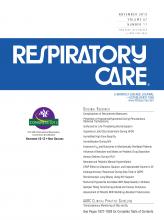Most patients with ARDS require mechanical ventilation to maintain adequate gas exchange and reduce the work of breathing. However, mechanical ventilation can induce lung injury by causing overdistention and repetitive opening and closing of unstable lung units.1 Low tidal volume ventilation has been shown to decrease mortality in patients with ARDS, compared to high tidal volume ventilation, by preventing overdistention.2 Selection of appropriate PEEP, sometimes with the use of recruitment maneuvers, is also important to maintain alveolar recruitment. However, the use of recruitment maneuvers remains controversial.3
The recruitment maneuver is usually accomplished by transient application of high-level CPAP, an increased PEEP with pressure controlled ventilation, or intermittent sigh. Proper selection of PEEP is important for the recruitment maneuver to be successful. Amato et al reported that a combination of low tidal volume, recruitment maneuver, and PEEP adjustment remarkably decreased the mortality in ARDS patients.4 Following a recruitment maneuver, they set the PEEP level at 2 cm H2O above the inflection point on the inspiratory limb of the pressure-volume curve. However, the ARDS Network failed to demonstrate that a higher PEEP strategy improved mortality in patients with ARDS.5 Unfortunately, they limited application of recruitment maneuver to the first 80 patients in that study, because the improvement in oxygenation following a recruitment maneuver was small and transient. They found no differences in mortality or ventilator-free-days between a higher PEEP strategy and a lower PEEP strategy. In more recent studies, recruitment maneuvers and/or a higher PEEP strategy reduced the incidence of hypoxemia,6 improved lung function, and reduced the duration of mechanical ventilation.7 But mortality did not decrease significantly. A possible explanation for these disappointing results may be insufficient PEEP following the recruitment maneuver.
It is reasonable to consider a recruitment maneuver in appropriately selected patients, such as early in the course of ARDS,8–10 and in patients with extrapulmonary ARDS.11 Procedures associated with alveolar de-recruitment, such as ventilator disconnection, endotracheal suctioning,12 endotracheal intubation,13 and tracheostomy, may also be good targets for a recruitment maneuver.
In this issue of the Journal, Franchi et al report the efficiency of a recruitment maneuver in prevention of hypoxemia associated with percutaneous dilatational tracheostomy.14 A unique point in this prospective study is that they examined the effect of recruitment maneuvers performed before the tracheostomy. Under mechanical ventilation with low tidal volume and FIO2 set at 1.0, 29 trauma patients with mild ARDS requiring tracheostomy were randomized into 2 groups: recruitment maneuver group and control group. The recruitment maneuver was a high level of CPAP (40 cm H2O for 40 s) applied 10 min before the percutaneous dilatational tracheostomy. In patients who underwent the recruitment maneuver, PaO2 values increased significantly, compared to the control group, and oxygenation was maintained at 5 min, 30 min, and 6 hours after the tracheostomy. It was likely that the recruitment maneuver decreased the volume of alveolar de-recruitment, which had been established before the tracheostomy, and that the effects of recruitment lasted at least for 6 hours. In this study, the authors carefully chose an appropriate patient population with a less severe condition (mild ARDS due to trauma), excluded the patients with high risk of barotrauma or hemodynamic instability, and appropriately adjusted the PEEP after the recruitment maneuver, on the basis of pressure-volume curves. One of the 15 subjects needed interruption of the recruitment maneuver, due to hypotension.
Although recruitment maneuvers are generally well tolerated, complications such as hypotension and desaturation may occur.15 Recruitment maneuvers may affect hemodynamics by decreasing venous return and by increasing pulmonary vascular resistance. However, such effects are expected to be transient, blood pressure and cardiac output returning to the baseline in several minutes, and serious complications may be not common.
Also in this issue of the Journal, Fan16 et al extracted information about complications during recruitment maneuvers from their previous multicenter randomized controlled trial.6 Of 475 patients with ARDS enrolled into a recruitment maneuver group, 366 patients received at least one recruitment maneuver, applying CPAP (40 cm H2O for 40 s) with FIO2 of 1.0. They found that respiratory and cardiovascular complications were common: desaturation (SpO2 < 85%) in 10% of the patients, hypotension (mean blood pressure < 60 mm Hg) in 11% of the patients, and tachycardia (heart rate > 140 beats/min)/bradycardia (< 60) in 5% of the patients. However, serious complications were uncommon; a new air leak through an existing chest tube was observed in 1%. By multivariable analysis, they found pulmonary ARDS, higher levels of baseline PEEP, and frequent application of recruitment maneuver were risk factors for these complications. Although these data come from one of the largest studies of recruitment maneuvers, further clarification is needed. First, the duration and reversibility of the complications are unknown. If they were just transient, interruption of recruitment maneuver might be reasonable and enough. Second, indicators to predict the complications due to recruitment maneuver are needed. Third, long-term risk and benefit should be evaluated, rather than just short-term outcomes.
When patients are selected properly, recruitment maneuver can be effective and safe. The method used to apply the recruitment maneuver may influence both the efficacy and potential for complications. Although recruitment maneuvers compromise respiratory and hemodynamic conditions transiently, serious long-term complications seem to be rare. To clarify the role of recruitment maneuvers in patients with ARDS, further clinical studies are needed, using a prospective randomized design with better consideration of patient profile, ventilator management, and methods of recruitment maneuver.
Footnotes
- Copyright © 2012 by Daedalus Enterprises Inc.







